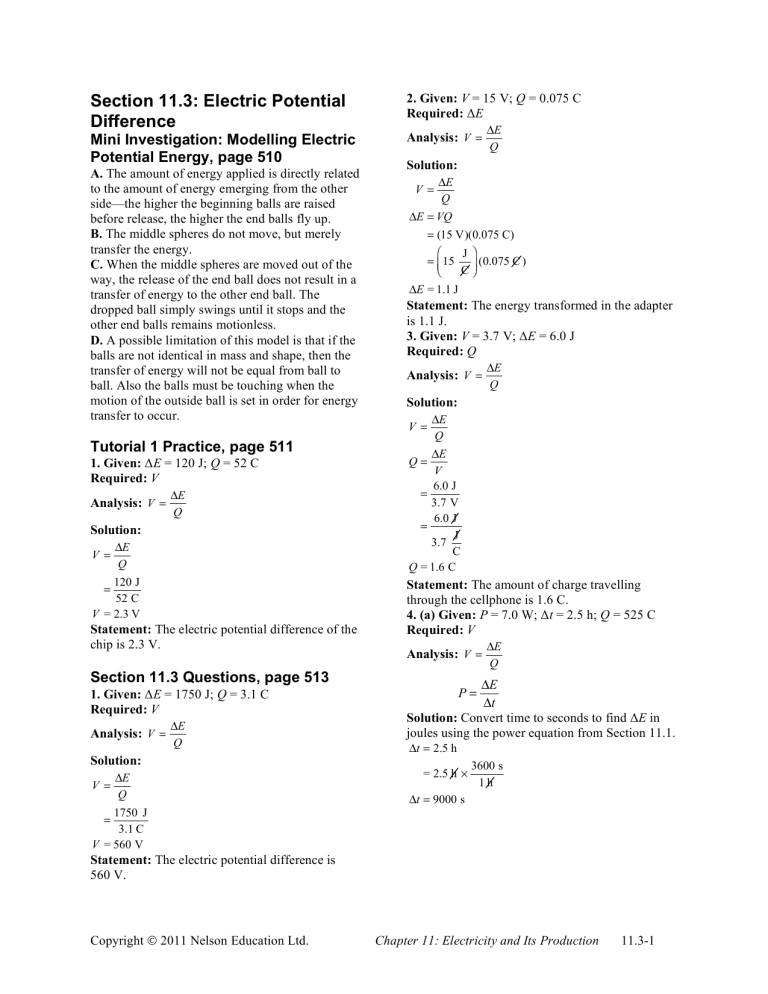Section 11.3: Electric Potential Difference

Section 11.3: Electric Potential
Difference
Mini Investigation: Modelling Electric
Potential Energy, page 510
A. The amount of energy applied is directly related to the amount of energy emerging from the other side—the higher the beginning balls are raised before release, the higher the end balls fly up.
B.
The middle spheres do not move, but merely transfer the energy.
C.
When the middle spheres are moved out of the way, the release of the end ball does not result in a transfer of energy to the other end ball. The dropped ball simply swings until it stops and the other end balls remains motionless.
D. A possible limitation of this model is that if the balls are not identical in mass and shape, then the transfer of energy will not be equal from ball to ball. Also the balls must be touching when the motion of the outside ball is set in order for energy transfer to occur.
Tutorial 1 Practice, page 511
1. Given: Δ E = 120 J; Q = 52 C
Required: V
Analysis: V = !
E
Q
Solution:
V = !
E
Q
=
120 J
52 C
V = 2.3 V
Statement: The electric potential difference of the chip is 2.3 V.
Section 11.3 Questions, page 513
1. Given: Δ E = 1750 J; Q = 3.1 C
Required: V
Analysis: V = !
E
Q
Solution:
V = !
E
Q
=
1750 J
3.1 C
V = 560 V
Statement: The electric potential difference is
560 V.
2. Given: V = 15 V; Q = 0.075 C
Required: Δ E
Analysis: V = !
E
Q
Solution:
V =
!
E
Q
!
E = VQ
= (15 V)(0.075 C)
=
#$
"
15
J
C &'
%
(0.075 C )
!
E = 1.1 J
Statement: The energy transformed in the adapter is 1.1 J.
3. Given: V = 3.7 V; Δ E = 6.0 J
Required: Q
Analysis: V = !
E
Q
Solution:
V = !
E
Q
Q
V
E
=
6.0 J
3.7 V
=
6.0 J
3.7
J
C
Q = 1.6 C
Statement: The amount of charge travelling through the cellphone is 1.6 C.
4. (a) Given: P = 7.0 W; Δ t = 2.5 h; Q = 525 C
Required: V
Analysis: V = !
E
Q
P = !
E
!
t
Solution: Convert time to seconds to find Δ E in joules using the power equation from Section 11.1.
!
t = 2.5 h
= 2.5 h "
3600 s
1 h
!
t = 9000 s
Copyright 2011 Nelson Education Ltd. Chapter 11: Electricity and Its Production 11.3-1
P =
!
E
!
t
!
E = P !
t
= (7.0 W)(9000 s)
J s &'
%
(9000 s)
!
E = 63 000 J
V = !
E
Q
=
63 000 J
525 C
V = 120 V
Statement: The electric potential difference of the
CFL bulb is 120 V.
(b) Multiply the number of coulombs in part (a) by the number of electrons per coulomb to find the number of electrons that were moved through the
CFL bulb:
525 C !
6.2
!
10 18 electrons
1 C
= 3.3
!
10 21
Statement: In part (a), 3.3 × 10
21
electrons
electrons were moved through the CFL bulb.
5. Given: Δ E = 130 J; V = 710 V
Required: Q
Analysis: V = !
E
Q
Solution:
V = !
E
Q
Q
V
E
=
130 J
710 V
Q = 0.18 C
Statement: The amount of charge delivered to the heart is 0.18 C.
6. (a) I would expect to observe a voltage gain across the battery because it increases the potential difference of the circuit, and to observe a voltage drop across the LED lamp because it is a load.
(b) I would expect no voltage drop or gain across the switch and the connecting wires, since they are conductors designed to have low resistances.
7. (a) A power plant is a source of electrical energy, so it causes a voltage gain.
(b) A digital camera is a load, so it causes a voltage drop.
(c) A game console is a load, so it causes a voltage drop.
(d) A wind turbine is a source of electrical energy, so it causes a voltage gain.
(e) A solar panel is a source of electrical energy, so it causes a voltage gain.
(f) A calculator is a load, so it causes a voltage drop.
8. (a) A voltmeter should not be connected in series. A voltmeter must always be connected in parallel.
(b) A circuit with more than one complete path is a parallel circuit. A series circuit has exactly one complete path.
(c) Connecting a voltmeter in series will not allow only a small amount of electrical energy to travel through it, since the electrons flowing through the circuit have no alternate path to follow and must pass through the voltmeter. Connecting a voltmeter in parallel will allow only a small amount of electrical energy to travel through it.
(d) A parallel circuit does not need to have only two complete paths. A parallel circuit can have two or more complete paths.
(e) A complete circuit contains a power source and a load but the power source must be switched on.
9.
Copyright 2011 Nelson Education Ltd. Chapter 11: Electricity and Its Production 11.3-2



